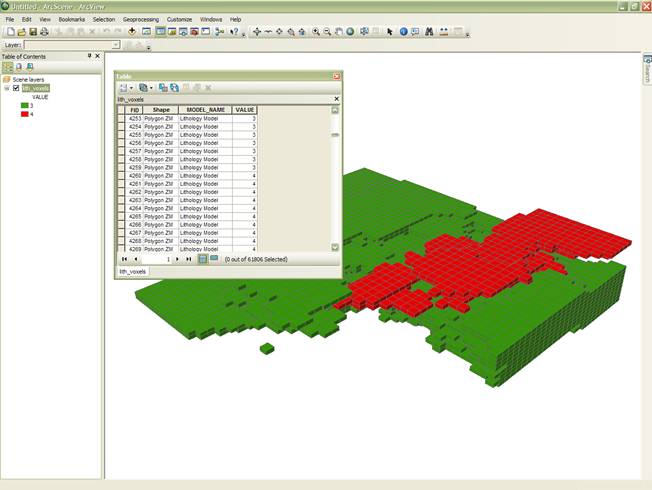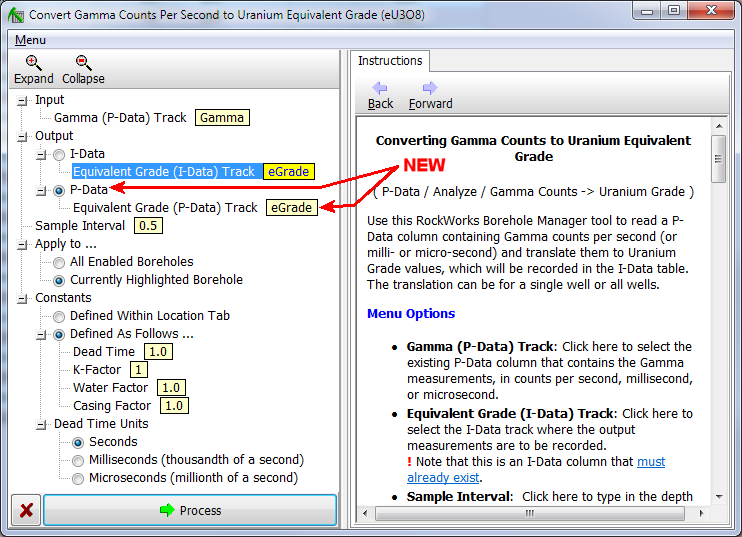(061) New Feature (02/16/11/JPR):
The Utilities / Coords / Longitude/Latitude -> UTM, Longitude/Latitude ->
State Plane, State lane -> Longitude/Latitude, and UTM -> Longitude/Latitude
programs have been consolidated into a new program titled "Longitude/Latitude
<-> UTM <-> State Plane".

This new program provides much greater flexibility for
converting between longitude/latitude, UTMs, and State Plane coordinates.

For example, it is now possible to convert from
SPCS-feet to UTM-meters.
(060) New Feature (02/16/11/JPR):
The RockPlot2D / Utilities / Lon/Lat->UTM and UTM->Lon/Lat options have
been replaced by a new program titled "Convert Map Coordinates".

The new Convert Map Coordinates program provides more
options for converting maps from one coordinate system to another including the
State Plane Coordinates.

(059) New Feature (02/16/11/JPR):
The RockPlot2D / File / Export / KMZ program now includes options for
converting diagrams that are in SPCS (State Plane Coordinate System) units to be
converted to longitude / latitude (a requirement for importing diagrams into
Google Earth).

(058) New Feature (02/15/11/JPR):
The Utilities / Coords / Jeffersonian Polygons -> XY program now includes
options for saving the output in SPCS (State Plane Coordinate System) units.

(057) New Feature (02/15/11/JPR):
The Utilities / Coords / Jeffersonian Points -> XY program now includes
options for saving the output in SPCS (State Plane Coordinate System) units.

(056) Removal (02/15/11/JPR):
The x-offset and y-offset options have been removed from the programs that
deal with PLS (Public Land Survey) data. These options were intended to be
used as a crude method for dealing with SPCS (State Plane Coordinate System)
data. Now that these program support direct SPCS conversions, these
offsets are superflourous and confusing.
(055) Cosmetic (02/15/11/JPR):
The "UTM Projection & Zone" tab within the Project Dimensions menu has
been renamed to "Projections & Zones" to accomodate the new State Plane
Coordinate options.

(054) New Feature (02/15/11/JPR):
The Borehole Manager / Map / Borehole Locations (Google Earth) now
supports datasets in which the eastings and northings represent decimal degrees
and state plane coordinates.

(053) Bug Fix (02/15/11/JPR):
The Borehole Manager / Map / Adjust Borehole Coordinates / Compute
Longitude Latitude / Based on UTM Meters program now works correctly.
(052) Bug Fix (02/15/11/JPR):
The Borehole Manager / Map / Adjust Borehole Coordinates / Compute
Longitude Latitude / Based on UTM Feet program now works correctly.
(051) New Feature (02/15/11/JPR):
The Utilities / Map / Land Grid / Section Map program now includes options
for handling projects in which the project dimensions represent SPC (State Plane
Coordinates) or decimal degrees.

(050) Bug Fix (02/14/11/MIW):
Unsupported characters within DXF layer names are now replace with underscore
characters ( "_" ).
(049) Bug Fix (02/11/11/MIW):
Exporting solid models to Google Earth no longer causes and "Out of
Memory" error.
(048) Bug Fix (02/11/11/MIW):
Exporting large models to Google Earth no longer creates model file names that
Google Earth can't read.
(047) Bug Fix (02/11/11/MIW):
Fixed a bug in the new Borehole Selector for the XY coordinate table that caused
the easting coordinates to be sent instead of the eastings and northings.
(046) New Feature (02/10/11/MIW):
Points for an XY coordinate table can now be added by borehole name.

(045) New Feature (02/09/11/MIW):
The Truncate options has been added to the straight-line stratigraphic
cross-sections.
(044) Cosmetic (02/07/11/MIW):
The Borehole Symbol & Label options dialog has a new, cleaner look.
(043) New Feature (02/07/11/MIW):
Numerical optional fields within the Location table can now be gridded and
contoured.

(042) New Feature (02/07/11/MIW):
Numerical optional fields within the Location table can now be displayed
as a "Bubble Map" from the Borehole Map menu.

(041) Removal (02/05/11/JPR):
All references to automatically calculated UTM zones have been removed.
Instead the UTM zone for all RockWorks programs is always considered to be that
specified by the user within the main Project Dimensions tab. Good
riddance to a well-intentioned idea that created a wealth of confusion.
(040) Bug Fix (02/05/11/JPR):
The Utilities / Map / LandMap / Section Map program no longer omits
sections whose area represents more than 1.5 square miles. The internal
omission threshold has been increased to 2.0 square miles. This threshold
is used to filter-out bad data within the BLM/USFS/USDA-based lookup-table
(LandBase).
(039) Bug Fix (02/02/11/MIW):
The Borehole Manager / Lithology / 2D-Isopach program now correctly
displays the borehole location symbols and labels.
(038) New Feature (02/02/11/MIW):
Borehole map labels can now include the option fields from the Location
Table.


(037) New Feature (02/02/11/MIW):
The Borehole Manager / Stratigraphy / Stratigraphic Thicknesses /
2-Dimensional (Isopach) program now allows the user to generate thickness maps
base on the top or base of any stratigraphic unit and the top or base of any
other stratigraphic unit thereby allowing the user to group multiple units into
a single isopach.

(036) New Feature (02/02/11/MIW):
Striplogs will now plot stratigraphic data when only the tops are defined.
This is accomplished by automatically setting the lower depths to the top-depths
for the next lowest unit. The depth to the base of the lowest entry is
assumed to be equal to the TD (total depth) for the borehole. In addition,
stratigraphic units may now be repeated.


Caveats:
-
This "relaxation" of the depth-to-base requirement
does not effect any of the model-based programs (e.g. stratigraphic
modeling, model-based cross-sections, etc.). These programs will
ignore any stratigrahic interval data that does not include a depth-to-base.
-
Subsequent processing with this type of data should
be limited to the following programs;
-
Stratigraphy / Structural Elevations /
2-Dimensional
-
Stratigraphy / Structural Elevations /
3-Dimensional / One-Surface
-
Stratigraphy / Structural Elevations /
3-Dimensional / All-Surfaces
-
Stratigraphy / Stratigraphic Thicknesses /
2-Dimensional
-
Stratigraphy / Section / Straight
-
Stratigraphy / Fence / Straight
-
Stratigrahy / Fence (ESRI Format) / Straight
-
All of the aforementioned programs will go "haywire"
if the stratigraphy includes repeated units. This capability was added
only for users who wish to plot striplog cross-sections that do not include
any type of stratigraphic correlation or modeling (e.g. striplog-only
cross-sections).
-
These changes were made for users who only work
with structural tops and don't require stratigraphic modeling
(035) New Feature (02/02/11/JPR):
A new program titled "Meters to Feet" has been
added to the Borehole Manager / Map / Adjust Borehole Coordinates menu below the
new "Convert Collar Elevations From ..." sub-heading. This program is
identical to the program described below (#34) except that it converts collar
elevations within the Location tab from meters to feet.
(034) New Feature (02/02/11/JPR):
A new program titled "Feet to Meters" has been
added to the Borehole Manager / Map / Adjust Borehole Coordinates menu below the
new "Convert Collar Elevations From ..." sub-heading. This program
converts collar elevations within the Location tab from feet to meters.

(033) New Feature (02/02/11/JPR):
A new program titled "Meters to Meters" has been
added to the Borehole Manager / Map / Adjust Borehole Coordinates menu below the
new "Convert Eastings/Northings From ..." sub-heading. This program is
similar to the program listed below (#32) except that it converts Eastings and
Northings within the location table from meters to feet.
(032) New Feature (02/02/11/JPR):
A new program titled "Feet to Meters" has been
added to the Borehole Manager / Map / Adjust Borehole Coordinates menu below the
new "Convert Eastings/Northings From ..." sub-heading. This program
converts Eastings and Northings within the location table from feet to meters.

(031) New Feature (02/02/11/JPR):
A new program titled "SPCS83 (NAD83 State Plane Coordinate System)
Meters" has been
added to the Borehole Manager / Map / Adjust Borehole Coordinates menu below the
new "Compute Longitude/Latitude Based On ..." heading. This program is
identical to the feature described below (#30) except that it treats the input
(eastings and northings) as meters rather than feet.
(030) New Feature (02/02/11/JPR):
A new program titled "SPCS83 (NAD83 State Plane Coordinate System)
Feet" has been
added to the Borehole Manager / Map / Adjust Borehole Coordinates menu below the
"Compute Longitude/Latitude Based On ..." heading.

This program is used to convert and export NAD83 State Plane Coordinates from
the Easting and Northing location fields to the optional Longitude/Latitude
fields.
(029) New Feature (02/01/11/JPR):
A new program titled "Longitude/Latitude -> SPCS83 (NAD83 State Plane
Coordinate System) Meters" has been
added to the Borehole Manager / Map / Adjust Borehole Coordinates menu below the
new "Compute Eastings/Northings Based On ..." sub-heading. This program is
identical to the item listed below (#28) except that it outputs the eastings and
northing in meters rather than feet.
(028) New Feature (02/01/11/JPR):
A new program titled "Longitude/Latitude -> SPCS83 (NAD83 State Plane
Coordinate System) Feet" has been
added to the Borehole Manager / Map / Adjust Borehole Coordinates menu below the
new "Compute Eastings/Northings Based On ..." sub-heading.

This program is used to convert the optional
Longitude/Latitude fields to Eastings and Northings (in feet) based on the State
Plane Zone that is defined within the new Project Dimensions / UTM Projection
sub-menu.
(027) New Feature (02/01/11/JPR):
A new program titled "State Plane -> Longitude / Latitude" has been
added to the Utilities / Coords menu.

This program is used to convert NAD83 State Plane
Coordinates (in feet or meters) based on the current zone selection within the
Display Project Dimensions / UTM Projection & Zone sub-menu (see item #25 below)
to decimal longitude/latitude within the Utilities Datasheet.

(026) New Feature (02/01/11/JPR):
A new program titled "Longitude / Latitude -> State Plane" has been
added to the Utilities / Coords menu.

This program is used to convert decimal
longitude/latitude coordinates within the Utilities Datasheet to NAD83 State
Plane Coordinates (in feet or meters) based on the current zone selection within
the Display Project Dimensions / UTM Projection & Zone sub-menu (see item #25
below).

This new program, along with a slew of other, related
programs described above, are based on the United States National Geodetic
Survey
SPCS83 Fortran source code by Edward E. Carlson and T. Vincenty
(2002).
(025) New Feature (02/01/11/JPR):
A new button titled "Index Map" has been added to the Display Project
Dimensions / UTM Projection & Zone submenu.

When clicked, this button will display an index map that
shows the various SPCS83 (State
Plane Coordinate System - NAD83) zone numbers.

(024) New Feature (01/31/11/JPR):
A new option titled "SPC-1983 (State Plane Coordinate) Zone" has been
added to the Display Project Dimensions / UTM Projection & Zone sub-menu.

This pull-down menu is used to select the State Plane
Coordinate System that will be used when converting State Plane Coordinate
within other/future RockWorks sub-programs.

Please note that this new capability only applies to the
latest state plane conventions (i.e. NAD83/SPCS83). It does not apply to
NAD27/GPPCGP conversions.
(023) Bug Fix (01/27/11/JPR):
The Borehole Manager / Map / Adjust Coordinates / Longitude\Latitude ->
Easting\Northing program now works correctly. The previous version would
use the "automatic" zone setting (which has recently been removed from this
portion of the program).
(022) New Feature (01/26/11/JPR):
A new program titled "GPX (Universal GPS) Waypoints" has been added to
the Utilities / File / Import menu.

This simple program extracts the ID, longitude,
latitude, elevation, and comments for waypoint data from a GPX file. It is
intended for users who need to transfer GPS data into RockWorks without the
intermediate steps of importing/exporting the data into another product (e.g.
MapSource).
GPX has become the quasi-universal format for GPS data
storage. For example, you can use this program to extract waypoint data
from a Garmin 550T GPS by connecting the USB cable directly to the GPS,
launching this program, navigating to the file of interest, and clicking on the
Process button.
Note: In order to use this program most
effectively, you should configure your GPS to output longitude latitude in
decimal degrees (hddd.ddddd°) as opposed to decimal minutes (hddd°mm.mmm') or
degrees-minutes-seconds (hddd°mm'ss.s"). This elimates a step (i.e.
converting to decimal degrees) later on when converting to other coordinate
systems such as UTM Meters.
(021) New Feature (01/25/11/JPR):
A new program titled "GT-Compositing" has been added to
the Borehole Manager / P-Data / Analyze menu.
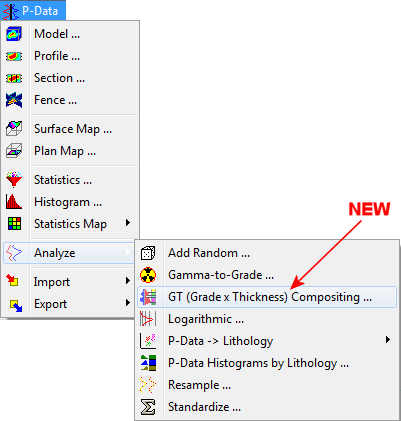
This program reads a column of P-Data that represents
grade values (e.g. eUranium) and computes a variety of GT (grade x thickness)
statistical information based on user-defined minimum grade and maximum
waste-thickness cutoff values.
The output from this program may be stored within an Excel-compatible CSV file,
I-Data columns, or a special XYZ file that may be used for subsequent
point-mapping and/or contouring.
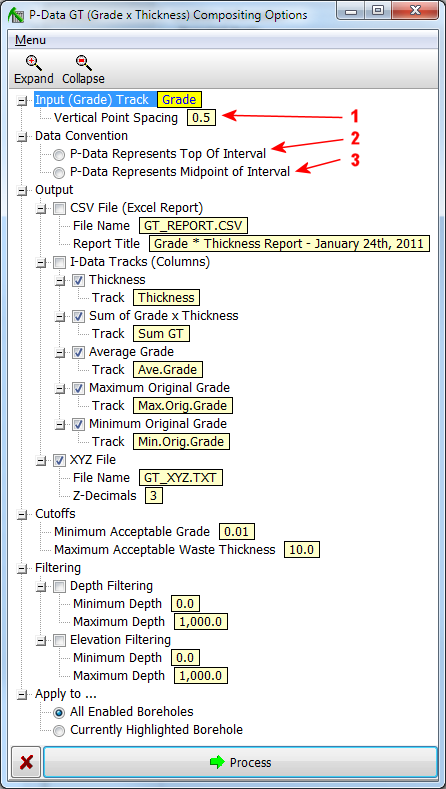
The P-Data / Analyze / GT-Compositing program is
identical to the I-Data / Analyze / GT-Compositing program (described as item
#20 below)
with the exception of how the input data is treated. Specifically;
-
The I-Data version does not require uniform point
spacing whereas the P-Data version does.
-
The I-Data version uses intervals that are defined
by a depth-to-top and a depth-to-base whereas the P-Data version requires
that the user specify the sampling interval
(see item #1 in menu example above).
-
The P-Data version defines an interval in one of two
possible ways;
-
If the P-Data represents the top of the interval
(see item #2 within the menu example above), the interval top will be
considered to be the original P-Data depth while the base of the
interval will be considered to be the P-Data depth plus the user-defined
vertical point spacing (see item #1).
-
If the P-Data represents the midpoint of the
interval (see item #3 within the menu example above), the interval top
will be considered to be the original P-Data depth minus half of the
user-defined vertical point spacing while the base of the interval will
be considered to be the original P-Data depth plus half of the
user-defined vertical point spacing.
(020) New Feature (01/24/11/JPR):
A new program titled "GT-Compositing" has been added to
the Borehole Manager / I-Data / Analyze menu.

This program reads a column of I-Data that represents
grade values (e.g. eUranium) and computes a variety of GT (grade x thickness)
statistical information based on user-defined minimum grade and maximum
waste-thickness cutoff values.
The output from this program may be stored within an
Excel-compatible CSV file, I-Data columns, or a special XYZ file that may be
used for subsequent point-mapping and/or contouring.
Terminology:
Menu Options:

-
Input (Grade) Track: This is
the I-Data track that contains the grade data. For example, this might
represent %eU3O8 (Uranium Grade Equivalent), ounces per ton Gold, etc.
-
Output: The output from this
program may be saved within a CSV file (described below), tracks (columns)
within the I-Data table, and/or an ASCII (American Standard Code for
Information Interchange) text file with xyz-style data for subsequent
mapping.
-
CSV File (Excel Report):
If checked, the output from this program will be saved within a
Excel-compatible CSV (Comma Separated Values) ASCII (American Standard
Code for Information Interchange) file as shown by the following
example.
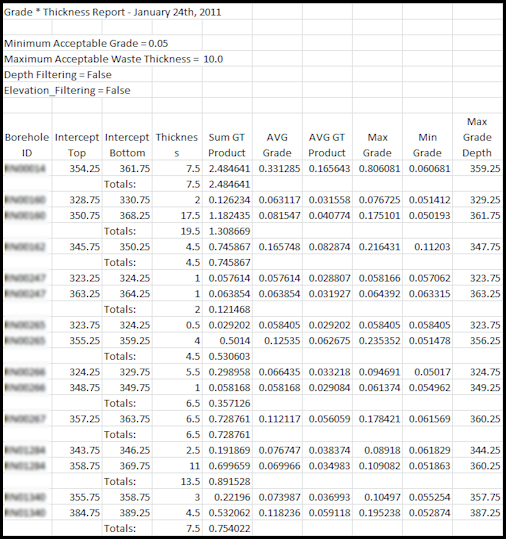
Because CSV files are "generic" (readable by a
wide variety of programs - including RockWorks), there is no formatting.
As a consequence, any special formatting such as column title centering,
font sizes, etc, must be performed by the user after the CSV file has
been auto-loaded into Excel. Note: If a CSV file with the
same name is already open when the program attempts to create this file,
the program will notify the user and ask them to either close the CSV
file within Excel or enter a different output file name.
-
File Name: This is
the name of the CSV file that will be created by the program and
automatically loaded into Microsoft Excel (or whatever program has
been associated, via your Windows settings, with the CSV file
extension.
-
Report Title: This is
the title that will appear within the first row of the CSV file.
-
I-Data Tracks: Check this
item if you want to export the output from this program into tracks
(columns) within the I-Data table as shown by the following example.
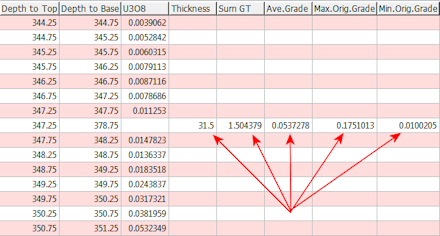
This I-Data may be incorporated within graphic
striplogs as shown by the following example.

Please note that the I-Data output columns must
be defined within the I-Data table before
this program is used.
-
Thickness: Check this
box if you want to store the intercept thicknesses.
-
Sum of Grade x Thickness:
Check this box if you want to store the sum of all grades multiplied
by the thicknesses for each sample interval within the associated
intercept.
-
Average Grade: Check
this box if you want to store the average grade for all sample
intervals within the associated intercept.
-
Maximum Original Grade:
Check this box if you want to store the maximum grade value for all
of the sample intervals within the associated intercept.
-
Minimum Original Grade:
Check this box if you want to store the minimum grade value for all
of the sample intervals within the associated intercept.
-
Depth to Maximum Grade:
Check this box if you want to store the depth to the maximum grade
within the associated intercept.
-
XYZ File: If checked, the
program will save an XYZ point within the designated file for each
borehole. The x-coordinate will contain the easting for the
borehole collar, the y-coordinate will contain the northing for the
borehole collar, and the z-value will represent the total for all "sum
of grade x thickness" values for that particular borehole.

This data is intended for plotting borehole
location maps in which the point label represents a summary to the
borehole's economic value. These values may also be contoured, but
(and this is important), inclined boreholes will produce misleading
contour maps since the xy location for each point always corresponds
with collar location. Please note that creating an XYZ file only
makes sense if you're processing all of the borehole (see "Apply to"
option below).
-
File Name: This is
the name for the ASCII file in which the tab-delimited xyz data will
be stored.
-
Z-Decimals: Number of
significant digits to use when saving the z-value (sum of GT
values). This setting is useful if the XYZ file is to be used
for creating a two-dimensional map as shown below.

Cutoffs: This are the primary
filtering values that are used to determine the extents of the ore
intercepts.
-
Minimum Acceptable Grade:
This value determines what is considered "acceptable" ore.
-
Maximum Acceptable Waste Thickness:
This value defines the amount of waste, or "interburden" that is
acceptable for zones that are bounded, above and below, by intervals
that contain material that have "acceptable" grade values.
-
Filtering: These options
allow the user to force the program to only consider input data within a
specified depth and/or elevation range.
-
Depth Filtering: If
checked, this setting will cause the program to only process data that
is between the specified minimum depth and the specified maximum depth.
We specifically avoid the terms "above" or "below" because the borehole
may be inclined upwards (e.g. an underground exploration hole drilled
upwards).
-
Elevation Filter: If
checked, the program will ignore all sample intervals above the maximum
elevation or below the minimum elevation.
-
Apply to: This program may be
used to compute GT-related values for just the currently-highlighted
borehole or all of the boreholes.
-
All Enabled Boreholes:
Compute GT-related values for all of the enabled boreholes (boreholes
that have a checked-box next to their names within the Borehole Manager.
-
Currently Highlighted Borehole:
Compute GT-related values only for the currently "active" borehole as
defined by an arrow adjactent to the borehole name within the Borehole
Manager.
(019) Bug Fix (01/24/11/JCJ):
When using a database served by an MS SQLServer, stratigraphic data within
Stratigraphy tab will no longer apparently disappear as it is inserted.
(018) Removal (01/23/11/JPR):
The "View Larger Map" button within the Principal Meridian selection
dialog has been removed now that the dialog is resizable.
(017) Improvement (01/23/11/JPR):
The Principal Meridian selection dialog is now resizable meaning that the
radio buttons will be automatically repositioned as the dialog size changes.
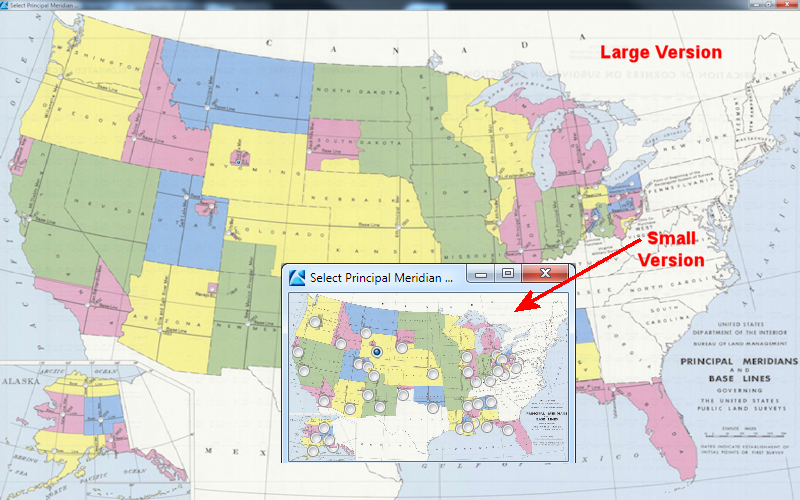
(016) New Feature (01/22/11/JPR):
The Utilities / Map / Land Grid / Section Map program has been re-designed
to take advantage of the new LandBase PLS (Public Land Survey) database (see
preceding New Feature listing below). These changes are described as
follows;

(1) The program now asks for the units that are
represented by the Project Dimensions in order to search the LandBase based on
coordinates in addition to the range, township, and section information.
(2) The map extents may now be defined by the current
Project Dimensions.
(3) The map extents may now be defined by a user-defined
"window".
(4) Section label dimensions are now expressed as a
percentage of the diagonal size of a section.
(5) Township label dimensions are now expressed as a
percentage of the diagonal size of a township.
(015) New Feature (01/21/11/JCJ):
The LandBase (Public Land Survey Range,Township,& Sections) database has
been updated to include data for all
of the
Public Land Survey
meridians based on BLM, USDA, USFS, etc. data. An index map
showing the new coverage is shown below.
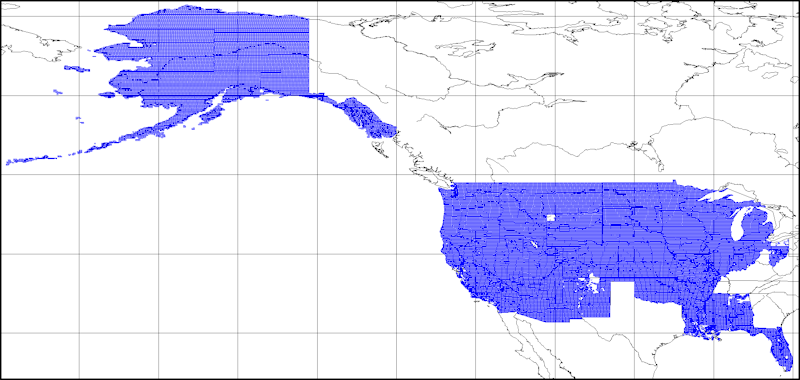
The structure for the LandBase files and associated
programs has been changed. As a consequence, the new LandBase files
must be downloaded from the
RockWare web site (by selecting the RockWorks / Help / Downloads option) if you
use any of the following programs;
-
Borehole Manager / Map / Adjust Coordinates /
Jeffersonian -> Easting/Northing
-
Utilities / Map / LandGrid / Section Map
-
Utilities / Map / LandGrid / Lease Map
-
Utilities / Map / LandGrid / Lease Map for Google
Earth
-
Utilities / Coords / Jeffersonian Points -> XY
-
Utilities / Coords / Jeffersonian Polygons -> XY
The new LandBase files are much larger (from 143mb to
351mb!) thereby requiring significantly more time to download from the RockWare
website (e.g. overnight).
Note: Some of the programs within RockWorks that use
LandBase may have unpredictable results when processing abnormal section or
township data. Utilities such as well-spotting and lease-plotting may
produce unpredictable results when dealing with sections that are convex
polyhedra.
For example, consider the hodgepodge of sections (below) within southern
Louisiana. The polygons that have been shaded yellow represent examples of
problematic sections.
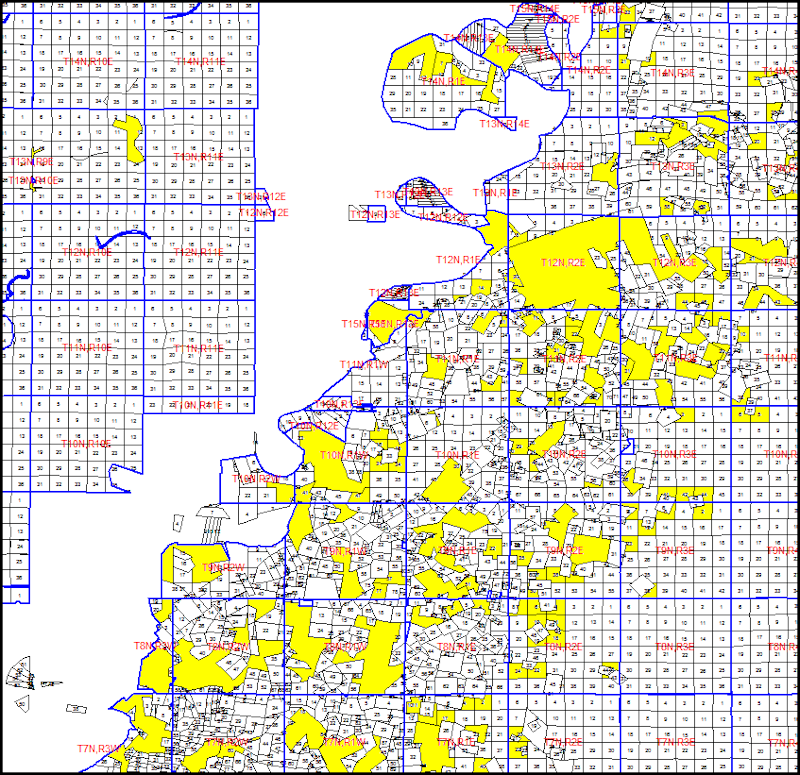
(014) New Feature (01/18/11/JCJ)
:
A new option for importing Longitude/Latitude data to the RockWorks
Longitude/Latitude fields (as opposed to the Easting/Northing fields) has been
added LogPlot import program.
(013) New Feature (01/18/11/JCJ)
:
The LogPlot import program can now add new fields to the location table in
order to store data from other fields within the Edit-Text tab in the same
manner that you can add these fields within the Excel/ASCII import programs.
(012) Improvement (01/18/11/JCJ)
:
The LogPlot import program now accepts easting, northing, and elevation data
with thousand-separators (e.g. commas).
(011) Bug Fix (
01/18/11/JCJ):
The LogPlot import program no longer fails when importing multiple LogPlot DAT
files.
